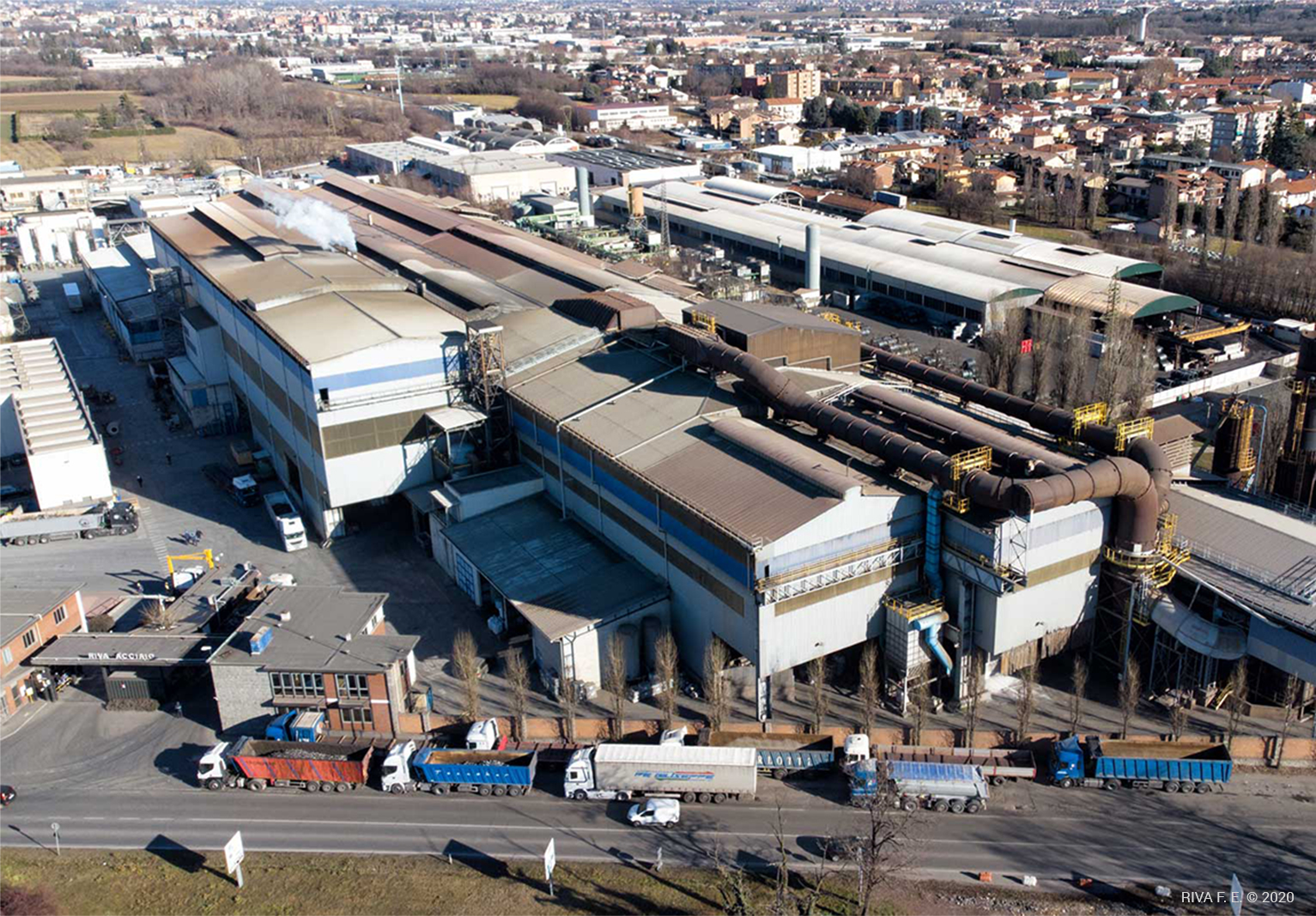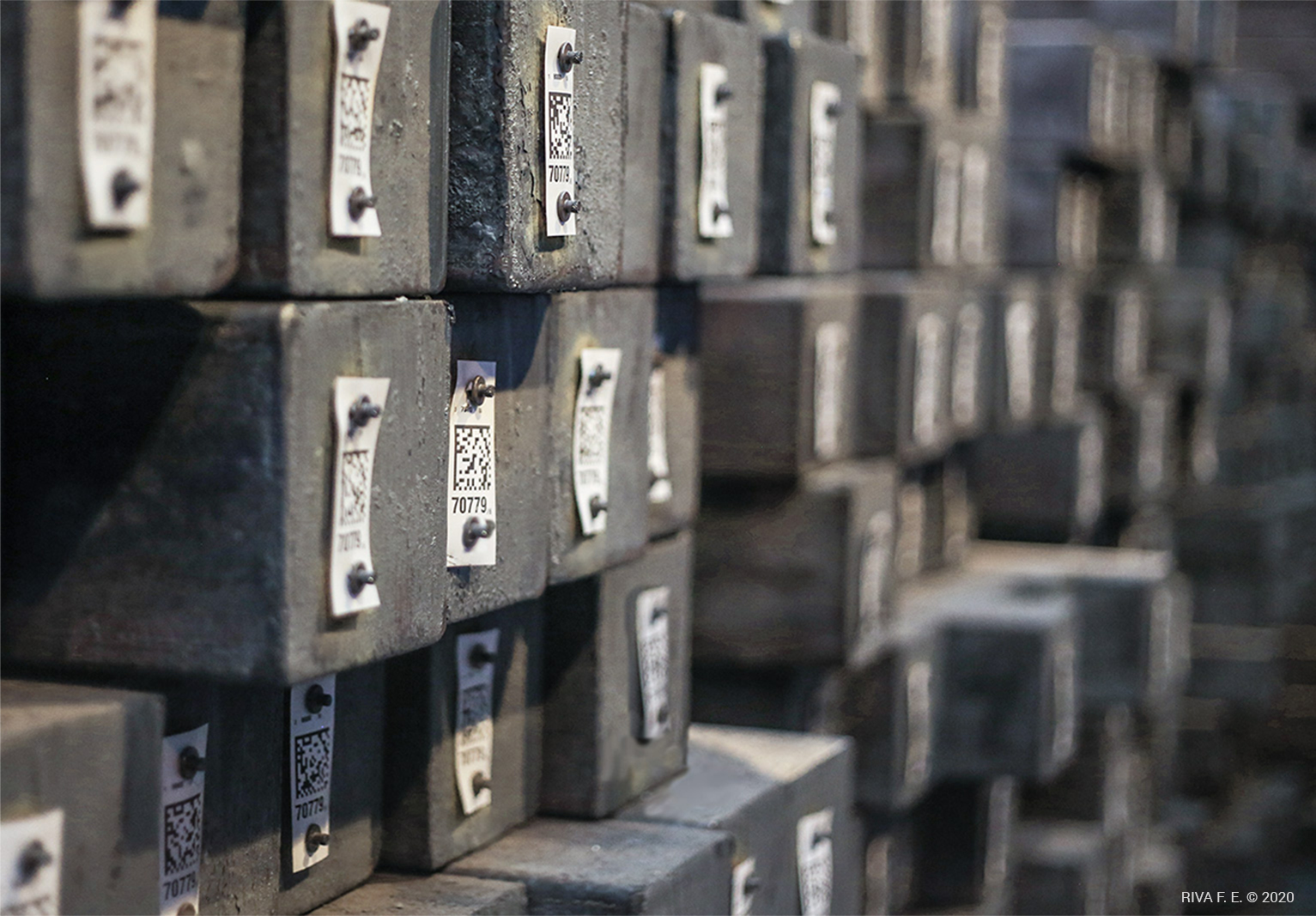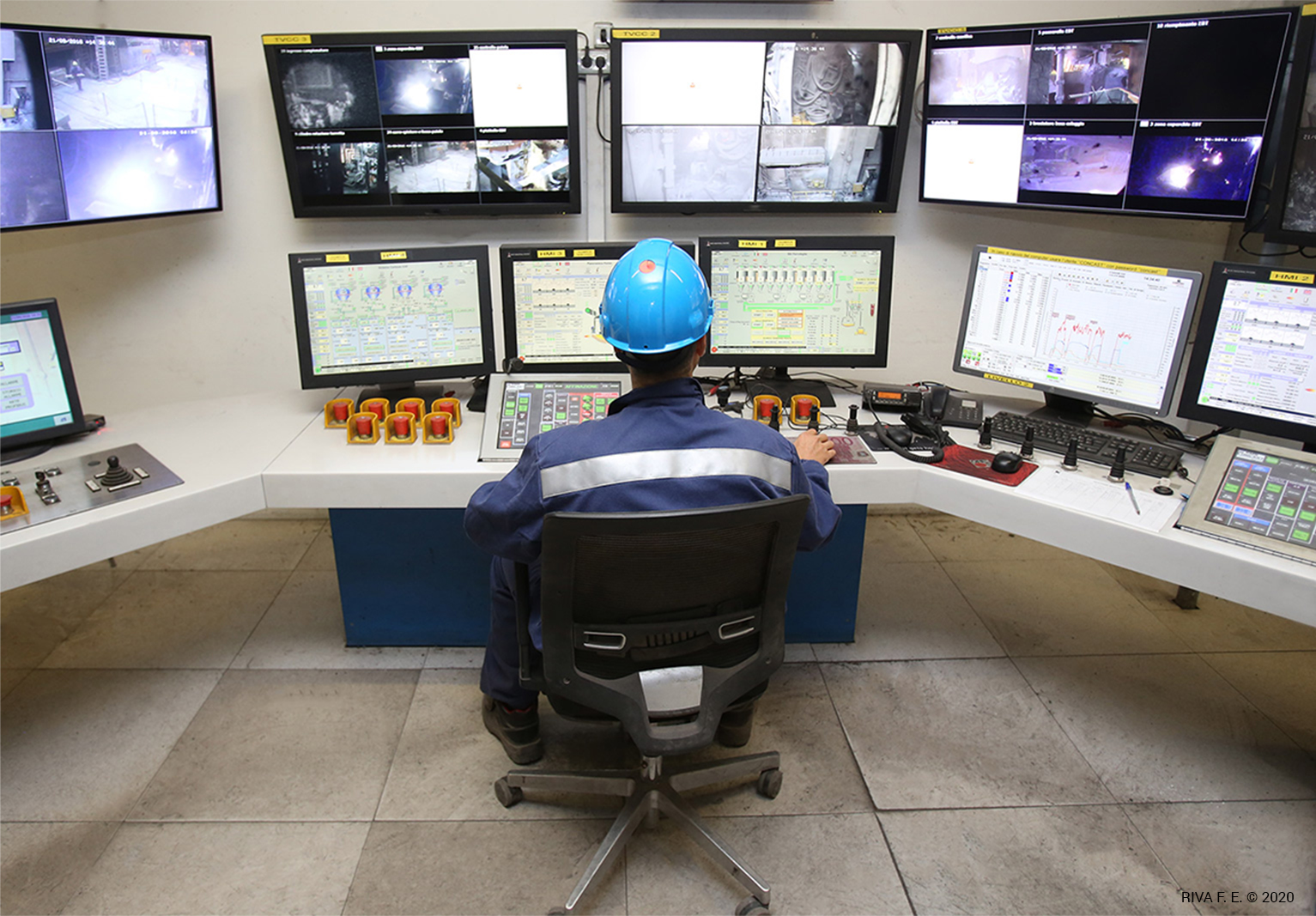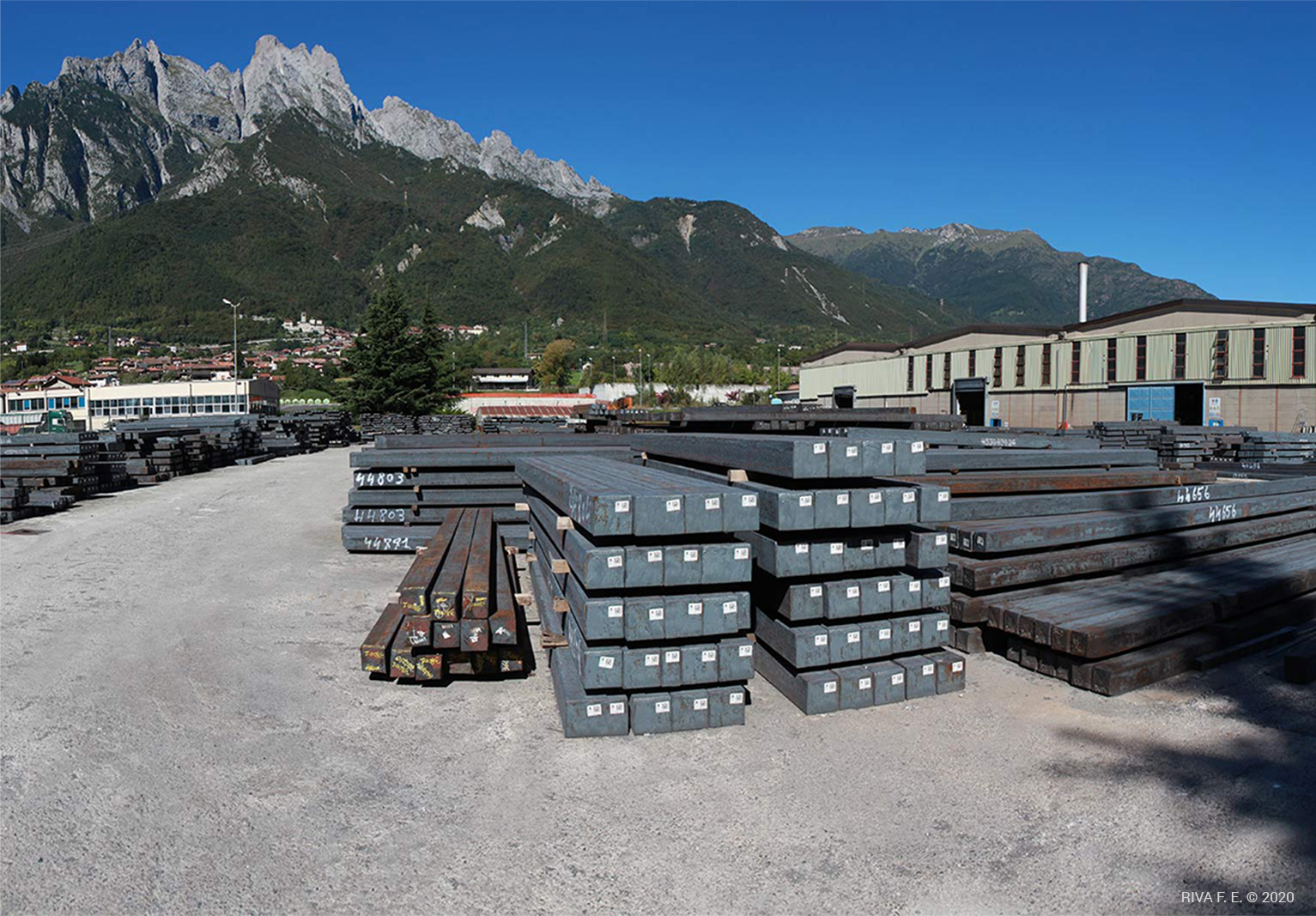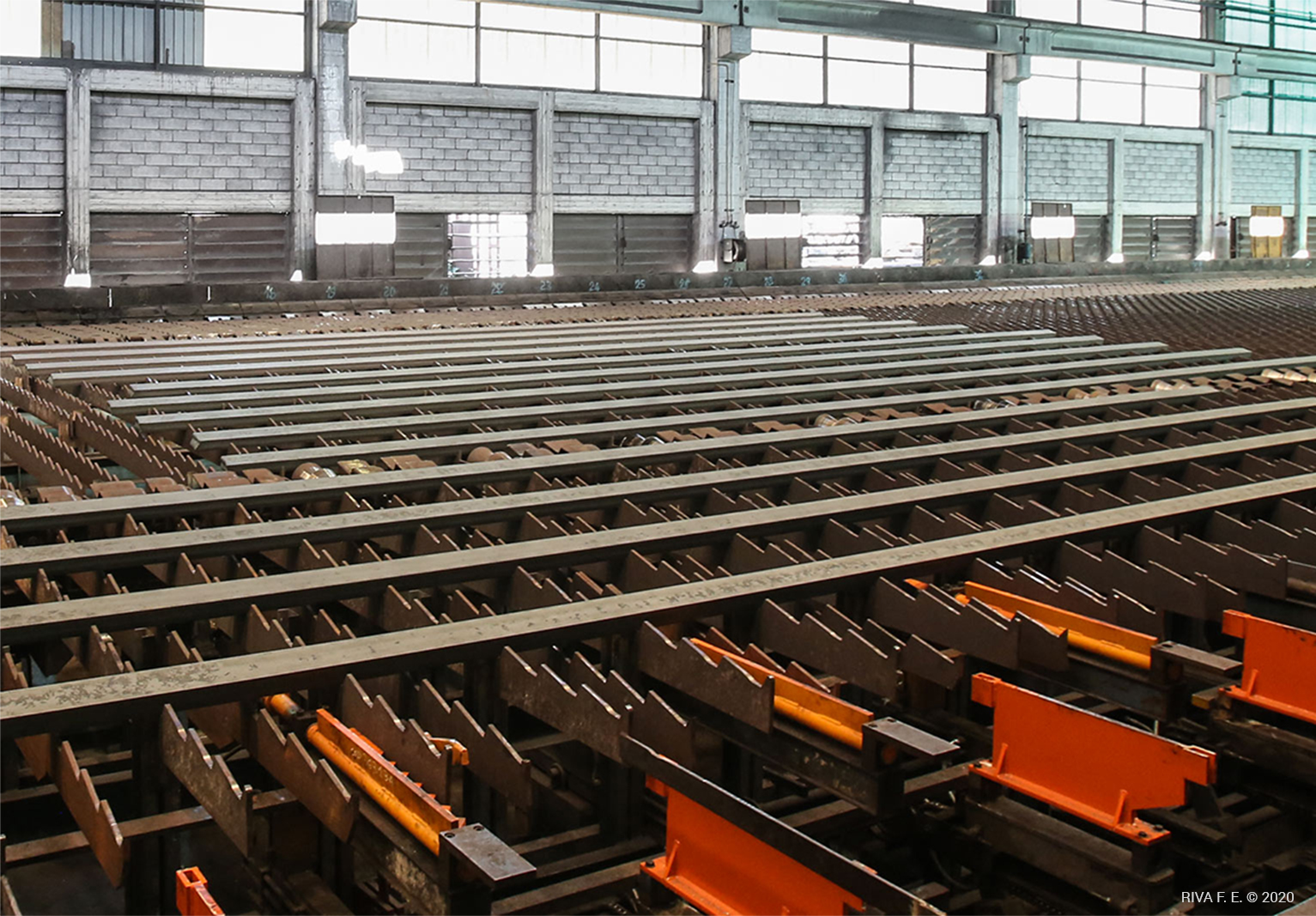It was 1954 – only a few years had passed since the end of World War II – when the Riva & C. s.a.s. was founded. The company collected and sold scrap metal to the steelworks in Brescia, which in turn processed it into end products – mainly concrete reinforcing rods – to be distributed by Riva & C. However, it soon became clear that the scrap metal business could not grow beyond a certain point and the company decided to take a giant step and moved from being a “supplier” to being a steel “manufacturer”. In 1956, in less than one year, the company bought some farmland in Caronno Pertusella, in the province of Varese, and built a steel mill from scratch.
The plant was at the cutting-edge of technology, especially because of its size: it was equipped with an electric arc furnace, produced by Tagliaferri, with a capacity of 25 t per heat, at a time when the largest furnaces in Italy still had a maximum capacity of 15 t. Detailed knowledge of the market and the investments made in the following years led to a very rapid growth in production - from 30,000 t in 1957 to 190,000 t in 1962 - partially driven by post-war reconstruction.
The first half of the 1960s marked an important period for the steel and iron sector.
Italian companies were exposed to increasing competition at international level, due to the development of very competitive small steelworks that used electric arc furnaces. Many businesses disappeared. To keep pace with big foreign steel manufacturers, it was imperative to invest heavily in research and innovation. Riva Acciaio took up this challenge and introduced a major technological innovation for the first time in Italy: three-line curved-type continuous casting.
At that time in Italy, continuous casting was performed only in the Terni steelworks in a one-line vertical continuous casting machine with a relatively low yield.
Emilio Riva was convinced that the way forward was curved-type continuous casting developed at the time in Austria, because it offered lower costs and higher yields compared to vertical continuous casting machines. The businessman contacted Luigi Danieli, owner of the company of the same name, and Renzo Colombo, a renowned designer, to develop this new technology together in Italy. The cooperation between the three men – the industrialist, the designer and the plant constructor – met with success: on 2 June 1964, the first continuous casting created by Danieli started operating in Caronno. It was the first three-line curved-type continuous casting process to be introduced into Italy, a major achievement for the Italian steel industry and especially for Riva Acciaio, because from that time onwards, the small-sized lingots that were later laminated into semi-products (billets) and into long products were abandoned altogether and the billets were obtained directly from liquid steel through this new process. The yield of the production cycle was improved and costs were reduced considerably.
With only one plant, it was not easy for the company to face Italian and foreign competition, which had become increasingly intense by that time. As a result, Riva Acciaio set out on a path of external growth and pursued a strategy of targeted acquisitions in Italy and abroad in the second half of the 1960s. The first double acquisition dates back to 1966, only two years after the introduction of the three-line curved-type continuous casting. Riva Acciaio acquired the Tanaro iron and steel works in Lesegno, in the province of Cuneo, and became a minority shareholder of SEII - Società Esercizi Impianti Industriali in Malegno (Brescia), taking over the management of this company. Positive results soon followed: by the end of the 1960s, annual steel production had increased to 300,000 t and the company was able to offer its clients a wide range of long rolled products, opening up promising new opportunities on international markets.
The 1970s were marked by the first major oil crisis and by a setback for the European steel industry, which was heavily affected by low-cost imports from South Korea, Mexico, Argentina and Brazil. Once again, Riva Acciaio chose to go against the trend and made its first investments at an international level. In 1971, the company acquired minority shares of Siderúrgica Sevillana (Spain) and later took over complete control of the plant. 1974 is the year in which Riva Acciaio expanded overseas by founding the Associated Steel Industries (ASI) in Montreal (Canada), a company created to select and recover scrap metal from the massive North American vehicle fleet. The company entered into the French market in 1976 with the acquisition of the Iton Seine steelworks, which were specialised in the production of high-quality concrete reinforcing rods and soon obtained the French CRELOI quality mark.
With regard to Asia, this period was marked by another significant milestone: in 1978, Riva was the first European player to sell steel directly to China, a market supplied exclusively by Japan prior to then. At the end of the 1970s, while many steel companies were depending on European Community and national funds to decommission obsolete plants (some of them must close), Riva Acciaio - which was by then an international Group in all respects - was investing heavily in new technologies, raising the level of automation in the casting process, increasing the number of computerised plants, fostering scientific research and exploring new possibilities for scrap metal supplies.
Thanks to landmark investments and many acquisitions in the previous 15 years, steel production exceeded the ambitious target of 1.1 million tonnes in 1980, more than tripling the production of the 1960s, and this turned Riva Group into one of the major players at a European level. Production was distributed across Europe as follows: 61% in Italy, 28% in Spain and 11% in France. Rolled steel production was close to 700,000 t, most of which was produced outside of Italy: 45% in Spain, 21% in France and only 34% in Italy. However, the company kept on growing. In 1981, another important acquisition was made: the Officine e Fonderie Galtarossa (OFG) company in Verona, which was specialised in high-quality reinforcing steel and in wire rods for drawing. Under the guidance of Riva Group, the company increased its production from 180,000 tonnes in 1980 to 740,000 tonnes in 2000.
In 1988, Riva Group was involved in another important privatisation in France, where it had been active for more than 10 years. The Group became the majority shareholder of ALPA (Aciéries et Laminoirs de Paris), which possessed a production plant (electric steel works and a rolling mill for reinforcing bars) at Gargenville. In 1989, after a further decade of expansion, Riva Group had tripled its steel production relative to 1980 and achieved steel production of 3.2 million tonnes (of which 2.1 were produced in Italy, and 1.1 in Spain and France) and 2.2 million tonnes of rolled steel, which represented approximately 10% of the reinforcing bar production in the EEC.
Between 1989 and 1992, the Group further expanded in countries with a long tradition in the iron and steel industry, such as Belgium and Germany. In Belgium, the rolling mill no. 3 of Charleroi-Marcinelle, with a production capacity of 750,000 tonnes/year, was bought and a new electric steel works was built from scratch to feed it. In this way, Thy-Marcinelle was created and the plant not only stabilised the employment situation in the area but also revitalised a region traditionally characterised by a significant presence of Italian workers. From that moment onwards, the region also received capital, advanced technologies and entrepreneurial skills from Italy.
In Germany, the Group profited from the privatisation of the steel industry that followed German reunification. Riva Group was able to acquire two steel plants located in the region around Berlin: Brandenburger Elektrostahlwerke and Hennigsdorfer Elektrostahlwerke. Both were bought in 1992 from the Treuhandanstalt, the German body in charge of the privatisation of ex-GDR companies. After these acquisitions, production increased from 749,000 and 360,000 tonnes, respectively, in 1992 to 1,283,000 and 811,000 tonnes, respectively, in 2000.
In 1994, with total production of 5.8 million tonnes of steel and 5 million tonnes of rolled steel, twice as much as just five years previously, Riva Group had grown to a size that placed it among Europe’s leading players. Expansion continued in the following years. In 1996, Riva Group bought the Sellero (BS) factory from the company IBL and in 2000 it acquired the French Group SAM (eight production and transformation plants and 1,500 employees) with production of 1.5 million tonnes of steel, 70% of which was processed into wire rod, electro-welded mesh and building products in the Group’s works.
In January 2023, the Riva Group acquired 4 collection sites and 4 sorting and shredding sites for scrap metal. The new plants have been grouped under the company TRENTETROIS and allow the group to aim for autonomy in the steel recycling chain, reaffirming one of its core values: sustainability.

